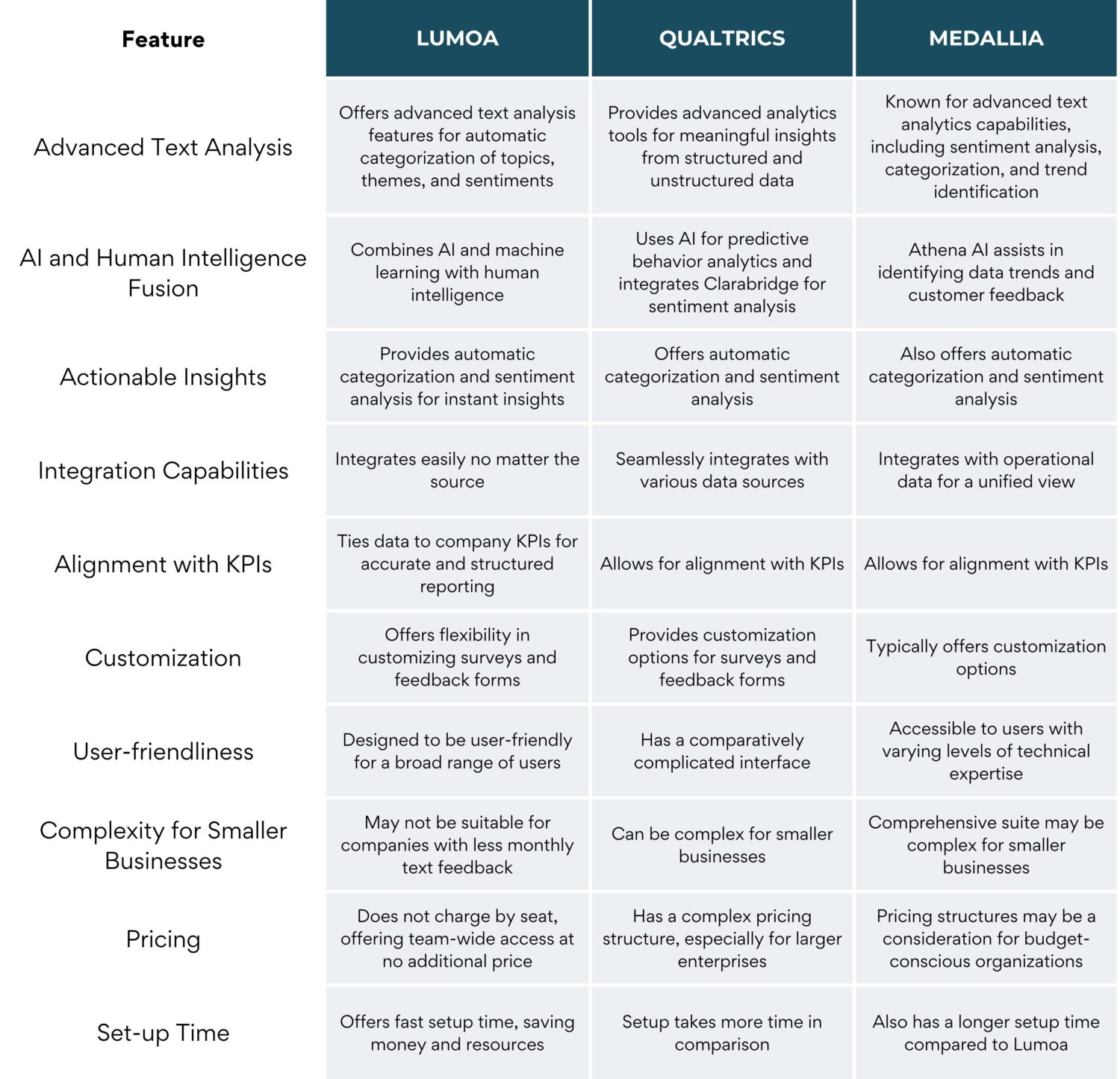A Guide to Choosing the Right Text Analysis Software for Your Business

Last updated on July 19, 2024
So, you’re eyeing growth and a healthy ROI for your business, right? I’m guessing that’s a big ‘yes.’ It’s a common goal, after all. And, if you’re nodding along, I’m also betting you’re savvy enough to know that the future of business success is tightly intertwined with embracing Machine Learning (ML) and Artificial Intelligence (AI).
Welcome to the ‘digital-everything’ era. AI tools are changing the way we analyze customer feedback. They’re not just speeding up the process; they’re enriching it with deeper insights, making it smoother and more efficient in terms of resources. This is where stepping up to text analysis software or a comprehensive customer experience platform becomes a big move for your business. It’s about making a strategic leap, not just keeping pace.
In This Article:
Understanding Text Analysis Software: A Brief Recap
The internet and social media are buzzing every second. There’s an avalanche of text data out there. Think about all the customer feedback we see – tweets, reviews, comments, surveys. It’s full of insights, but only if we can effectively gather, structure, and analyze it. That’s where text analysis, or text mining, comes into play.
To remind you a bit of what it is and what it does, text analytics uses and transforms unstructured text into structured data that’s actually useful for business decisions. Integrating customer experience analytics and conversational analytics into this process enhances our ability to understand and improve the customer journey by analyzing direct interactions and feedback in real-time
Whether it’s a tweet, a customer email, or a product review, text analysis software digs in, using Natural Language Processing (NLP) to identify key phrases and customer sentiments. Is the feedback positive, negative, or neutral? What’s the intensity of these sentiments?
To put it in a real-world scenario, take Amazon as an example. Imagine the sheer volume of reviews it gets daily. Text analysis software categorizes these into positive, negative, and neutral, picking up on language cues and common phrases. And for them, this isn’t just about numbers; it’s about understanding the ‘why’ behind customer opinions.
Key Features and Benefits of Text Analysis Software
When you’re in the market for text analytics software, it’s not just about slick interfaces (UI) or smooth user experiences (UX). It’s also about finding a tool that meshes with your business’s heartbeat – including your KPIs, budget, data processing goals, and, importantly, your CX strategy. Just focus on the features and benefits that will help your decision-making more efficient and cut through the clutter.
-
Sentiment Analysis: Picture this – Let’s say Apple launches its newest iPhone. The market reacts, and reviews pour in. Sentiment analysis steps in, swiftly categorizing these reviews as positive, negative, or neutral. This isn’t just data; it’s an immediate, clear-cut view of customer reception.
-
Language Detection: This one is self-explanatory. We know Apple’s global. Their customers? Speaking a myriad of languages. This feature automatically detects and analyzes these languages, making global customer support and feedback analysis a breeze. It’s about understanding your customers, no matter where they are.
-
Entity Recognition: This is about getting a grip on the specifics, the nitty-gritty details that paint the full picture of the data and its significance. This means recognizing “Apple” as the brand, “iPhone 15 Pro” as the model, and “iOS” as the operating system.
Sometimes, it can take it further – identifying key components in customer reviews like “battery life,” “camera quality,” and “ease of use.”
-
Keyword and Relationship Detection: Here’s where it gets interesting. This feature doesn’t just pick up on terms like ‘battery life’ or ‘camera quality.’ It takes the connections too – how these terms relate to sentiments like ‘disappointing’ or ‘impressive.’ It’s a deeper dive into the customer psyche.
-
Summarization: With generative AI getting more recognition, having this is almost a must on any platform. This feature distills lengthy feedback into concise reports. Imagine summarizing the sentiment on ‘camera quality’ across thousands of reviews with a click of a button. Ain’t that powerful?!
-
Topic Modeling: This is the opposite of digging deeper into the sentiment. Topic modeling is about seeing the bigger picture. Identifying overarching themes like ‘Camera Performance’ or ‘Battery Life’ helps categorize feedback into meaningful chunks, offering a bird’s-eye view of customer opinions.
-
Customizable Taxonomies: Every business is unique, and this feature should be able to adapt to the business needs. This kind of feature helps a user create and customize categories like ‘Feature Enhancements’ or ‘User Experience’ to tailor the analysis to your specific needs.
-
Real-time Analysis: In a fast-paced market, staying updated is key. If there’s a sudden spike in negative feedback about ‘camera quality,’ you’ll know instantly. It’s about being proactive, not reactive.
-
Advanced Reporting and Visualization: Data can be dry, but not with this feature. It turns analysis into visually appealing reports, making them easier to grasp and act upon.
-
Contextual Grasp: Context matters right? This feature goes beyond mere keywords, understanding the sentiment behind phrases like ‘battery doesn’t last long’ versus ‘impressive night mode camera.’
-
Multichannel Integration: To put it simply, this is a don’t miss a beat feature. This ensures no valuable insight slips through the cracks, whether it’s social media comments, email feedback, or survey responses.
-
Machine Learning (ML) Integration: Stay ahead of the curve. As language evolves, so should your software, adapting its analysis to new feedback patterns and trends.
-
Efficient Market Research: An in-house market research feature? why not! This will grant you cost effect and rapid results revealing customer behaviors, thought processes, and even purchasing probabilities.
It’s like giving Apple a crystal ball, that will help them make data-driven decisions that not only enhance the iPhone’s market share but also keep them ahead of their competitors.
-
Product Development Insights: Spot trends and customer preferences, guiding your next product iteration to align with market demands and expectations.
Now you might say, that’s a lot of things to consider. Well, choosing the right text analysis software isn’t a decision to be rushed. It’s about finding the perfect fit for your unique business needs and goals. Remember, one size doesn’t fit all.
Questions to Ask Before Choosing Your Ideal Text Analysis Software
Now that we’ve explored the advanced features and benefits of text analysis software, it’s time to ask, “What is the right tool for me?” When Choosing Your Ideal Text Analysis Software, you want to have a solution that resonates with your unique business needs. To guide you through this crucial decision, here are some key questions to ponder.
-
Advanced Features: Does it have features like sentiment analysis, entity recognition, and machine learning integration?
-
Customization: Is it possible to tailor the software to your specific requirements?
-
Integration Capabilities: Is it compatible with existing tools and systems that you are using?
-
Language Support: Does it offer multilingual support to process diverse data sources?
-
Real-time Analysis: Does the software offer real-time insights for quick decision-making?
-
Ease of Use: Does it have a user-friendly interface to allow seamless integration into your company workflow?
-
Reporting and Visualization: How easy is it to comprehend the interpretation of insights in terms of reporting and visualization?
-
Filter Comparison: Does it have comparison features to identify differences between different departments, products, countries, or survey sources to find root causes of problems?
-
Set Up Time: How long does it take for the software to be up and running so you save resources and time?
-
Cost and Value: Is the pricing structure cost-effective for your company? Maybe a freemium, trial period etc. is available to test it first?
-
Feedback and Reviews: Are the reviews in the market satisfactory and positive?
-
Training and Support: Does it offer training resources and customer support?
-
Scalability: How big can the software handle large volumes of data as your business evolves?
-
Data Security: Does it practice robust security measures to protect sensitive information?
-
Compliance: Does the software comply with relevant data protection and privacy regulations in your or customers’ location?
Each of these questions is a key piece of the puzzle in selecting a text analysis software that not only meets your current needs but also grows with your business.
At a Glance: A Few Prominent Text Analysis Solutions to Consider
There are various text analysis software options out there and it can be daunting to check them out one by one. To give you a clearer picture, we’ve put together a comparison of three Customer Experience platforms:
- Lumoa: Lumoa is the first CX platform to offer a Generative Pre-trained Transformer (GPT) and is known for its advanced text analysis. Every employee can ask relevant questions and receive detailed, real-time answers directly from customer voices, no matter where the feedback is given. And they can make timely decisions that will improve KPIs up to three times.
- Qualtrics: Qualtrics is recognized for its comprehensive text analytics capabilities, including sentiment analysis, language detection, and AI-driven insights, catering to a wide range of business needs.
- Medallia: Medallia is recognized for its omnichannel text analytics, AI-driven insights, and multilingual support, making it a strong contender in the text analysis software market.
Think of this as your quick guide to understanding how different solutions stack up against each other, especially in choosing the right text analysis software for your business.
Below are comparisons designed to help you pinpoint what matters most for your feedback program. Keep in mind, though, that this is just a snapshot for illustrative purposes – the real-world capabilities of these platforms might have even more to offer.

Conclusion
Choosing the right text analysis software can be a maze. There’s a lot to mull over – features, accuracy, customization, you name it. The key? Do your homework, set clear goals, and ask the tough questions. It’s about finding the perfect puzzle piece to drive your business.
Your business is unique, and your software choice should reflect that. Don’t hesitate to use resources like G2 Crowd and Capterra for the latest insights and user experiences.
We’ve compared Lumoa, Qualtrics, and Medallia to give you the insights you need. Each platform has its own flavor of genius and areas ripe for growth.
Lumoa, for instance, really shines with its top-notch features, being the first platform to offer GPT, user-friendliness, and a pricing model that’s hard to beat. Plus, their commitment to being a one-stop-shop for customer experience management? That’s the cherry on top.
Here at Lumoa, we’re more than just a platform; we’re your co-pilot on this journey towards a data-driven, standout customer experience platform. If you’re ready to step up your CX, with the right text analysis software, we’re all ears and ready to roll.
No matter which path you choose, remember this – it’s a big move for your business. Leveraging data insights isn’t just smart; it’s a total game-changer. Get in touch with us and see how we can help improve KPIs up to three times.
